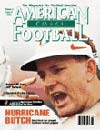AMERICAN FOOTBALL MONTHLY THE #1 RESOURCE FOR FOOTBALL COACHES
Article CategoriesAFM Magazine
|
Nothing teaches like an example...Oregon offensive coordinator Jeff Tedford uses an innovative method of QB instruction to get huge results from his pupils.by: Ron Bellamy © More from this issue You could call it Jeff Tedford's School for Quarterbacks. Graduates include NFL first-round draft choices Trent Dilfer, now with the Baltimore Ravens, and Akili Smith of the Cincinnati Bengals. The professor's preferred prerequisites for admission are toughness, intelligence, competitiveness, athletic ability and arm strength. In that order. Required supplies are pencils, paper, a VCR and a football. Oh, yes, and a set of checkers. Class is in session virtually all year at the University of Oregon. Tests are Saturdays in the fall. Of the many examples of fine work by Tedford's students, consider these numbers: in his two seasons as offensive coordinator and quarterbacks coach for the Ducks, Tedford's quarterbacks have thrown 807 passes with only 17 interceptions in passing-oriented offenses that were hardly conservative,....The full article can only be seen by subscribers.
|
|
|||||||
| HOME |
MAGAZINE |
SUBSCRIBE | ONLINE COLUMNISTS | COACHING VIDEOS |
Copyright 2025, AmericanFootballMonthly.com
All Rights Reserved





